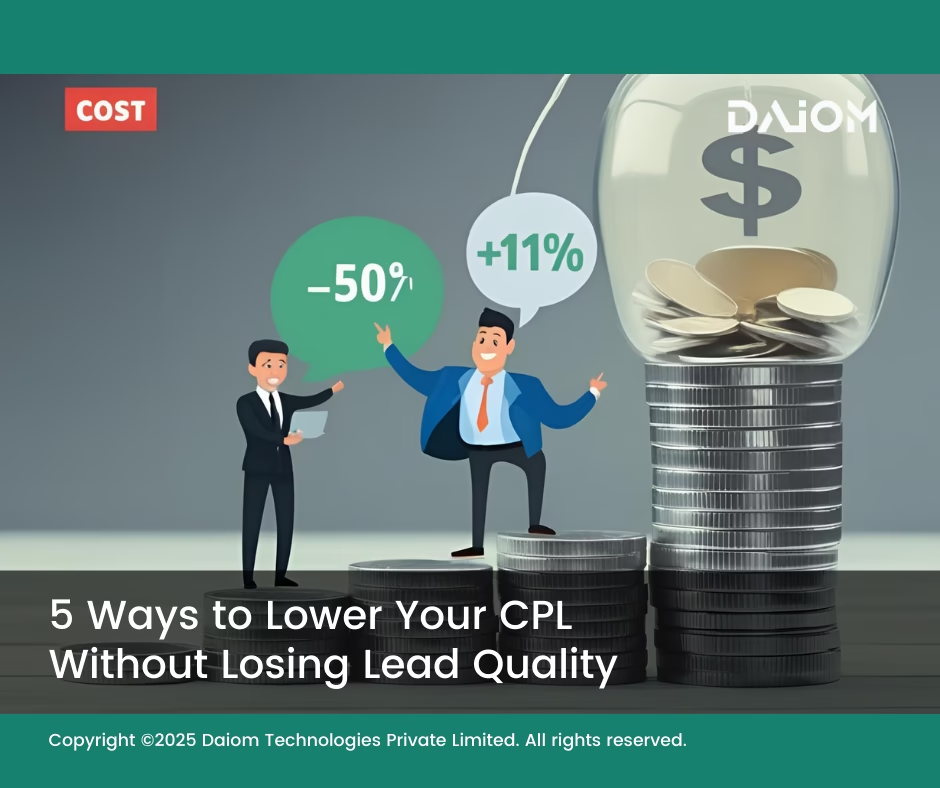Getting leads is easy. But getting the right leads at the right cost—and guiding them through a well-structured funnel—is the real challenge.
Who needs to look at CPL closely?
For B2B and high-ticket omnichannel brands—where buying decisions take time and often need assistance—generating leads is more important than direct sales. These businesses can’t always rely on self-checkouts or impulse purchases. They need a structured approach, and that’s where Cost Per Lead (CPL) becomes a crucial metric.
CPL tells you how much you’re spending to bring in a potential customer. But many brands focus only on running campaigns—without fixing the lead funnel, i.e., how those leads are captured, qualified, and followed up.
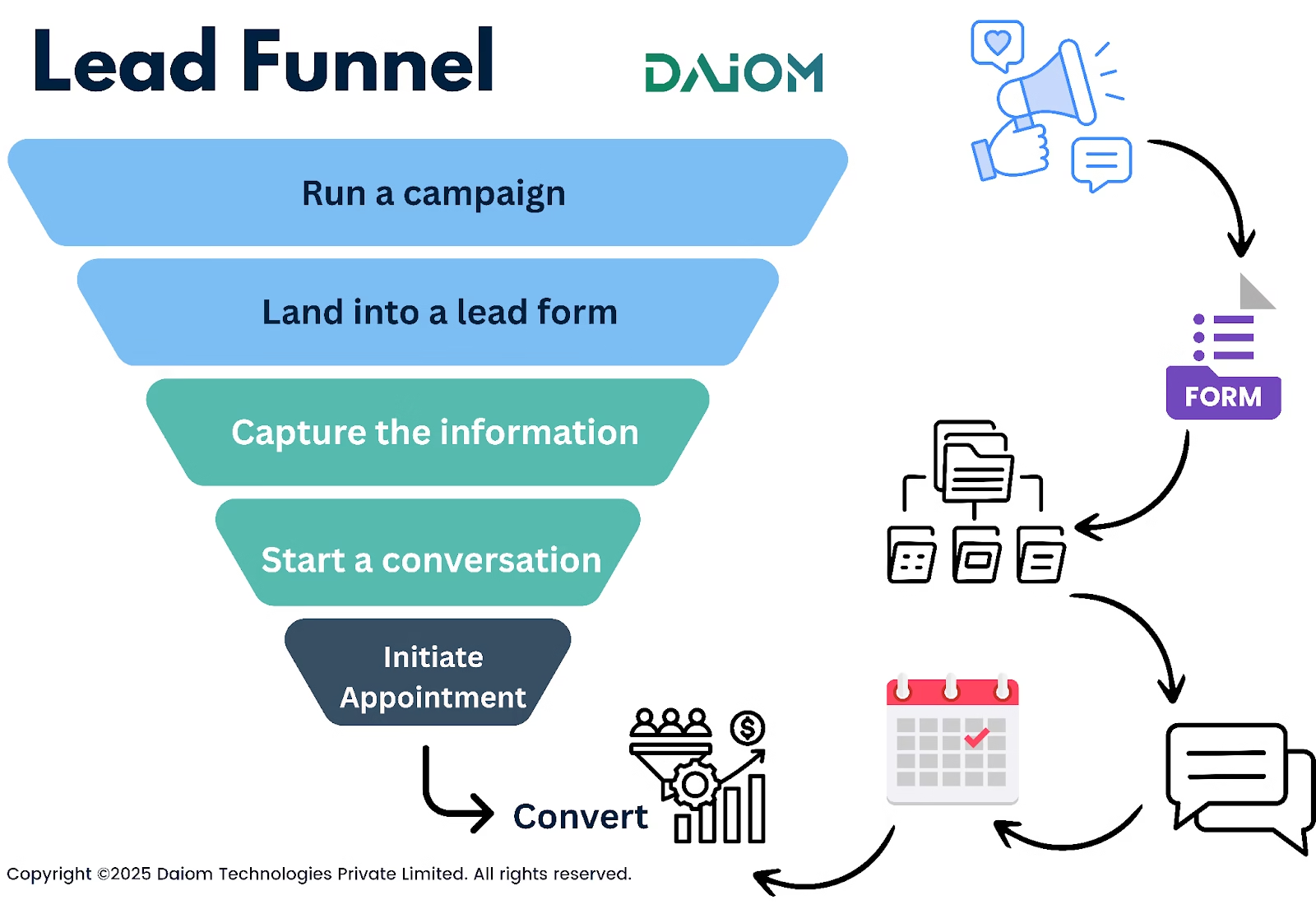
As a result, they end up with poor-quality leads or spend too much to get good ones.
And that’s a problem. Because the average CPL is already high—around $53 across industries, and even more in sectors like tech or finance. With ad costs rising, it’s getting harder to scale profitably.
So, how do you control your CPL while still getting quality leads?
In this blog, we’ll break down the real reasons why CPL rises—and share 5 proven ways to bring it down with smarter strategies, not just bigger budgets.
"Marketing without data is like driving with your eyes closed."
— Dan Zarrella, Social Media Scientist, HubSpot
Table of Contents
1. Why Does Cost Per Lead Matter?
CPL tells you the average amount you spend to acquire one lead through a specific marketing activity or channel. And knowing this simple number can help you in a big way:
- See What’s Working: CPL shows which campaigns or channels are giving you the best leads at the lowest cost. That means you know where to invest more and where to cut back.
- Improve Accountability: It makes your marketing results clear and trackable. This helps your team stay focused on what truly drives business outcomes—not just likes or clicks.
- Increase Profitability: The lower your CPL, the more efficient your marketing. By attracting quality leads for less, you can improve conversion rates and get more value from your budget.
This is especially important for industries with longer sales cycles or complex solutions, like engineering or tech. In these cases, CPL becomes a useful guide for making smarter marketing decisions and improving ROI.
2. What is Cost Per Lead (CPL)?
Cost Per Lead (CPL) is the amount of money you spend to get one potential customer—someone who shows interest in your business. This interest could come from actions like filling out a contact form, signing up for a newsletter, or downloading a free guide.
Because CPL tells you how much you’re paying to bring people into your sales funnel. It helps you understand how effective your marketing is—and if you’re spending wisely.
2.1 How to calculate Cost Per Lead?
Cost Per Lead (CPL) = Total Campaign Cost ÷ Number of Leads Generated

Let’s take an example: You run a Facebook ad campaign that costs ₹10,000. It brings in 100 leads.
CPL = ₹10,000 ÷ 100 = ₹100 per lead
Now suppose you run a Google Ads campaign for the same ₹10,000 budget, but it only brings in 50 leads.
CPL = ₹10,000 ÷ 50 = ₹200 per lead
This simple comparison shows you where your money is performing better. In this case, Facebook is giving you leads at half the cost compared to Google Ads.
2.2 What’s a Good Cost Per Lead?
A good Cost Per Lead (CPL) varies by industry, but generally falls between $15–$100. What’s “good” really depends on your customer lifetime value — if leads convert well and generate strong ROI, even a higher CPL can be worth it.
For example, industries like Furniture, Legal, and Business Services typically have higher CPLs, over $70, due to longer sales cycles. In contrast, industries like Automotive Repair or Animals/Pets usually have lower CPLs, under $20.
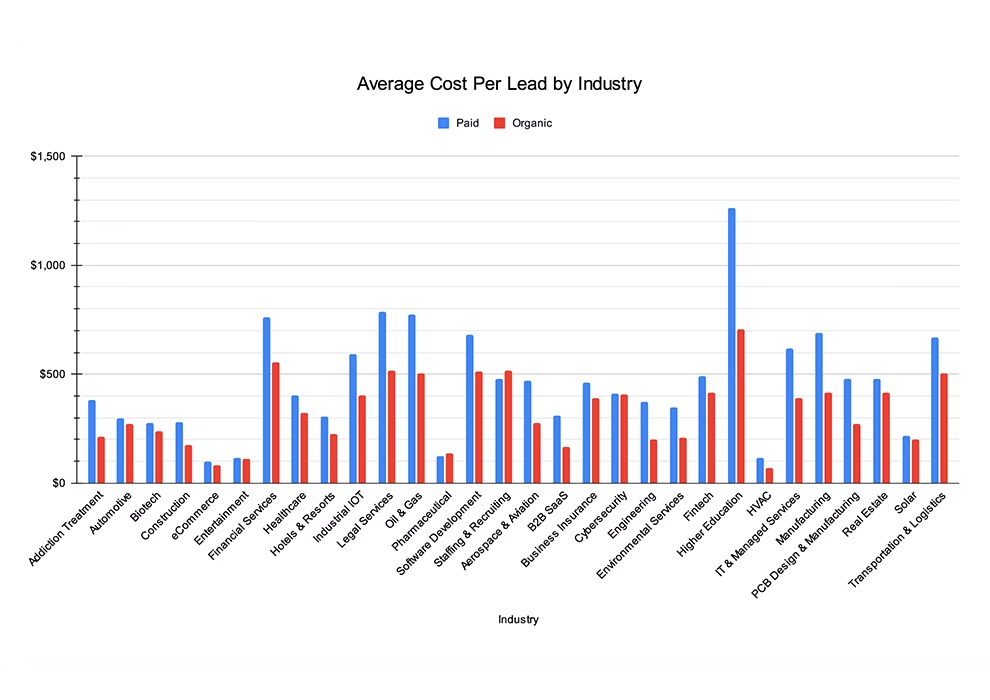
Within your own campaigns, CPLs may differ depending on the keywords and the value of the offer. Some leads may be more valuable, so it’s okay to pay a higher CPL for those.
To determine a good CPL, compare your costs with industry averages and the potential value of each lead to your business.
3. Why Your CPL Might Be High?
If your cost per lead (CPL) is higher than expected, it might not just be because of your ad budget. There are a few common reasons why CPL increases—and some of them are easy to avoid.
- External Factors: Privacy rules (like Apple’s iOS updates or GDPR) have made ad targeting less accurate. Higher competition in paid media means more brands are bidding for the same audience—driving costs up.
- Too Many Changes at Once: Many marketers try to improve results by changing everything at once—keywords, ad copy, and bidding strategy. But this often backfires. It is because platforms like Google Ads and Meta use algorithms that learn over time. When you change too much too quickly, these algorithms have to restart and relearn what works. That “reset” can lead to a temporary drop in performance—and higher CPL.
- Not Enough Time for Learning: If you’re under pressure to get fast results (especially after budget cuts), it’s tempting to keep tweaking campaigns. But if you don’t give your campaigns time to learn and optimize, you may end up wasting money rather than saving it.
4. 5 Proven Ways to Reduce Your Cost Per Lead
A lower CPL means you’re getting more qualified leads for less money, increasing your return on marketing investment. Here are five actionable ways to reduce your CPL effectively:
4.1. Ditch Lead Forms & Use Conversational Forms (on WhatsApp)
Instead of a boring lead form, use a conversational flow—especially on WhatsApp, where users already spend time. You can ask for name, intent, budget, or product interest—all in a friendly, chat-style format. It’s fast, engaging, and natural.
Read more: Are Lead Forms Dead? How Can Brands Use Conversational Forms To Drive Leads?
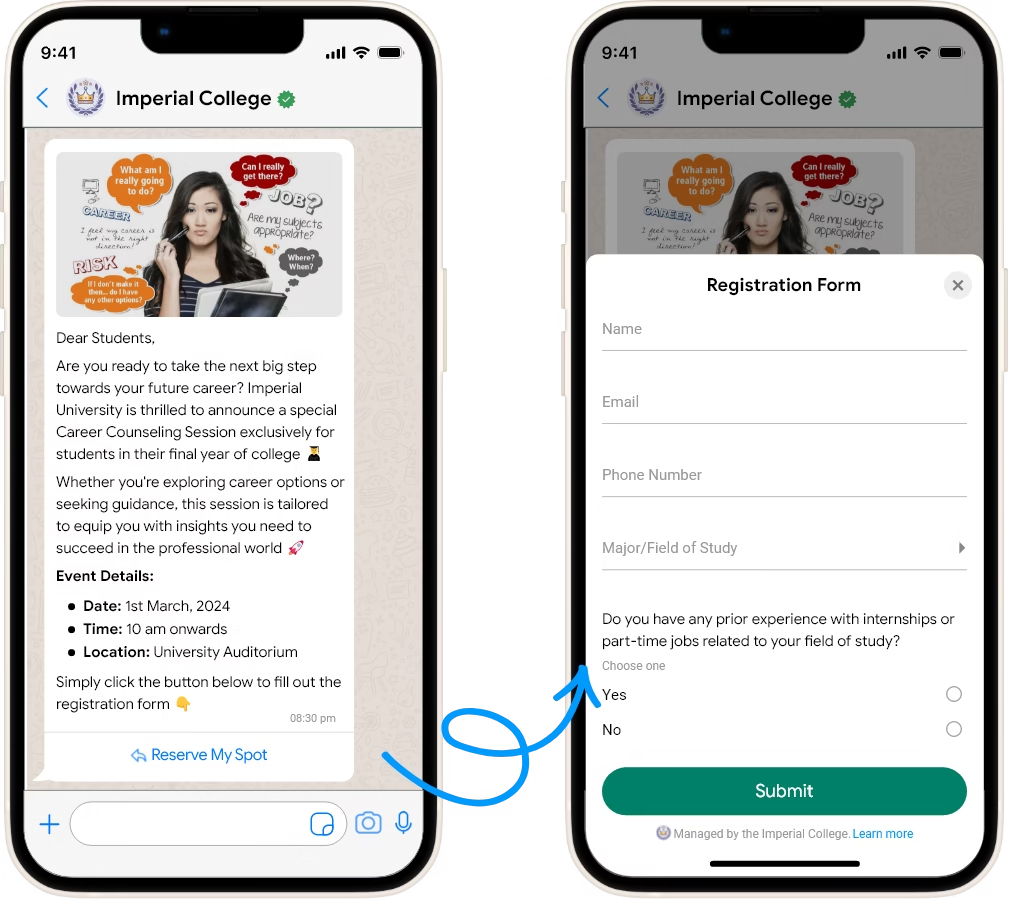
Why this works:
- Higher response rates
- Real-time qualification
- No drop-offs between form fill and sales call
4.2. Run CTWA (Click-to-WhatsApp) Ads
Click-to-WhatsApp (CTWA) ads send people directly from your ad to a WhatsApp chat. No middle steps. No landing page drop-offs.

You can instantly start a conversation, answer questions, and qualify leads right there. It’s perfect for B2B or high-ticket products where buyers want help before deciding.
Why this works:
- Eliminates friction
- Builds trust through personal interaction
- Speeds up conversion
4.3. Use Remarketing to Convert Interested Visitors
Not everyone converts the first time they see your ad. Remarketing helps you re-engage people who visited your website or interacted with your brand but didn’t take action.
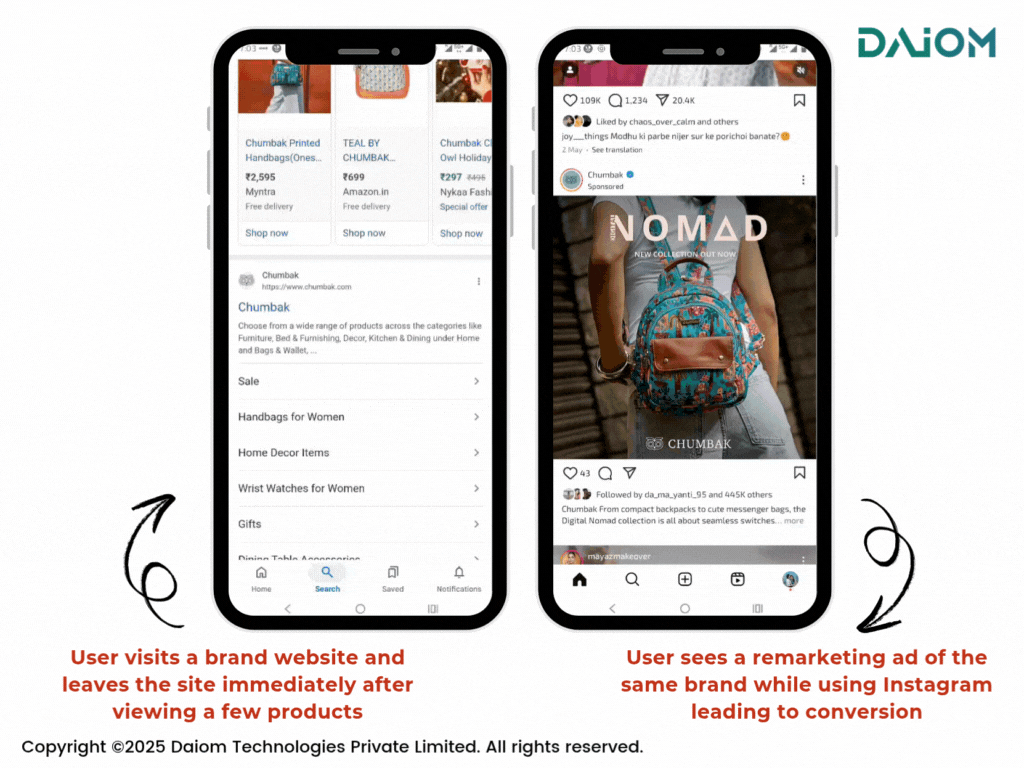
These ads are typically cheaper and highly effective because they target people who’ve already shown interest. A simple reminder ad can be enough to push them toward a purchase or form fill.
Why this reduces CPL: You’re not paying to reach a cold audience. You’re investing in someone who’s already halfway there—making conversions easier and cheaper.
4.4. Expand Your Reach with Advantage Detailed Targeting or Lookalike Audiences
Sometimes your audience is too narrow, and it drives up the cost to reach them. Facebook’s Advantage detailed targeting or Lookalike Audience features allow you to expand your reach to users who behave like your ideal customers.
Instead of relying on strict targeting rules, you allow the algorithm to find similar users likely to convert—often at a lower cost.

Why this reduces CPL: A broader but still relevant audience increases impressions and conversions while keeping costs down.
4.5. Use Automated Optimisation Tools for Smarter Bidding
Platforms like Meta offer optimization tools that automatically adjust bidding and delivery to get the best results at the lowest cost. These tools analyze millions of signals in real-time and prioritize ad delivery to the most cost-effective leads.
It’s important not to interfere too early. Let your campaigns exit the “learning phase” so the algorithm can optimize properly.
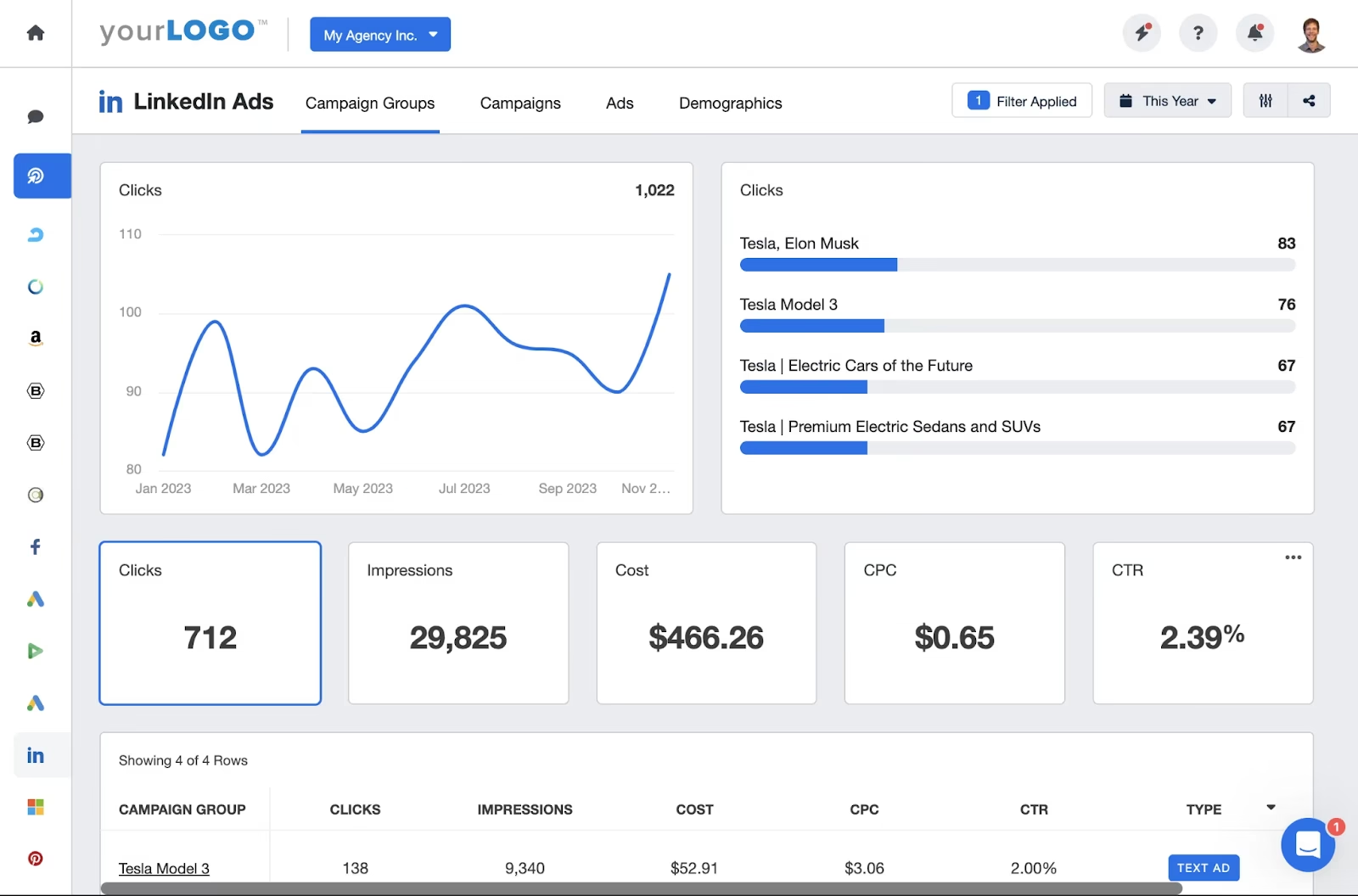
Why this reduces CPL: You let the system do the heavy lifting to find cheap and quality leads without manual adjustments that might hurt performance.
5. Industries Already Winning with Conversational Lead Generation
Many forward-thinking brands are already moving away from static lead forms and seeing great results with WhatsApp and conversational ads. Here are some that are doing it well:
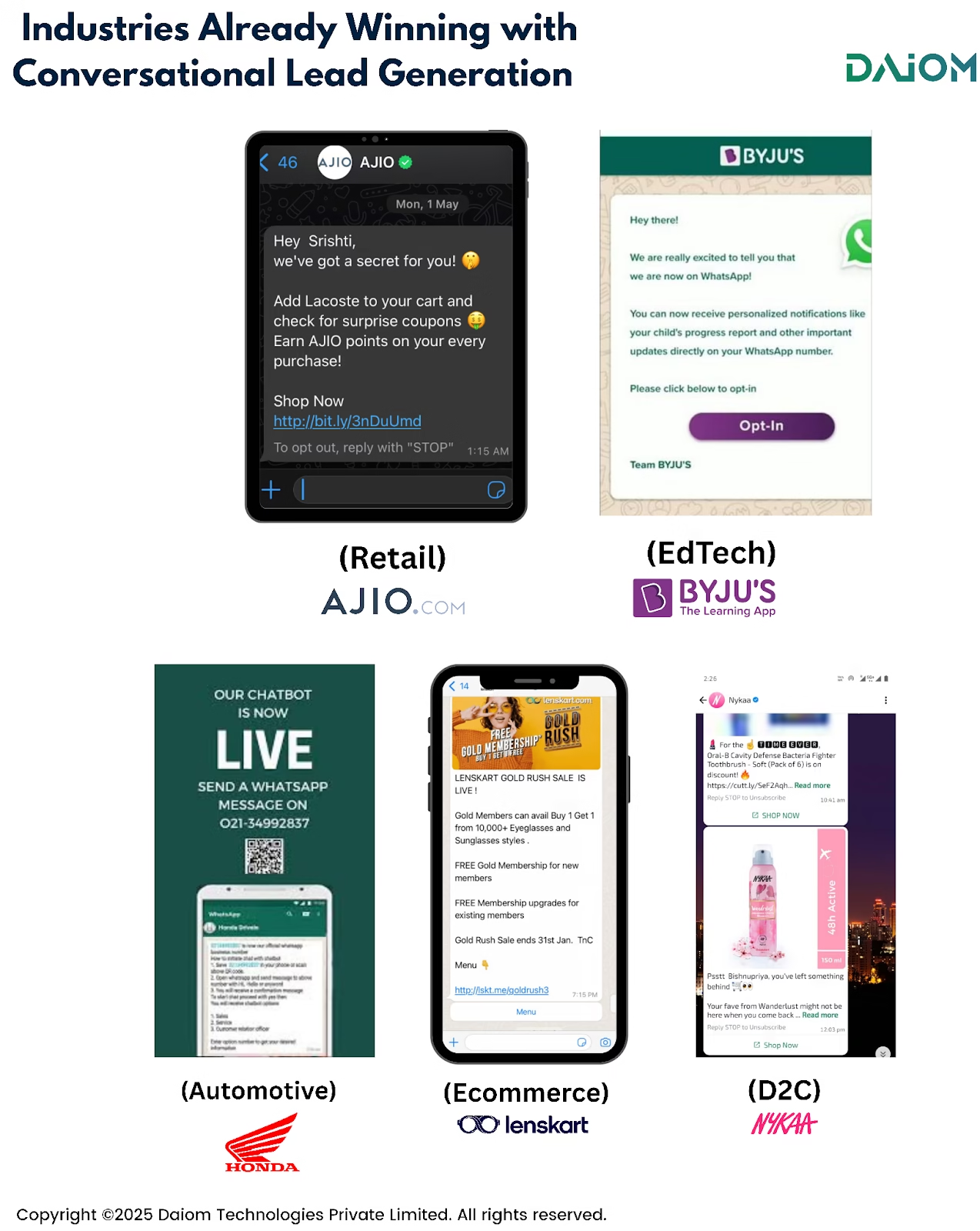
Here are a few examples:
- Real Estate – Using CTWA ads to chat instantly, share property info, and schedule site visits. Example: Lodha Group uses WhatsApp to manage inquiries and schedule site visits.
- Automotive – Scheduling test drives, sharing offers, and answering questions via WhatsApp. Example: Honda enables test drive bookings and follow-ups through WhatsApp.
- B2B SaaS – Replacing demo forms with instant lead qualification through chat. Example: Zoho uses conversational interfaces to guide leads through product exploration.
- Healthcare & Wellness – Booking appointments and giving basic consultations on WhatsApp. Example: Practo allows users to book appointments and receive reminders via WhatsApp.
- Education & Coaching – Handling course inquiries, brochures, and scholarships via conversation. Example: Byjus used WhatsApp to share course details and guide learners through the enrollment process.
- D2C & Ecommerce– Assisting buyers, resolving doubts, and preventing cart drop-offs in real time. Example: Nykaa and Lenksart uses WhatsApp for personalized support, new launch offers, discounts, cart abandonments and more.
6. Conclusion
Reducing your Cost Per Lead doesn’t mean cutting corners. It means making smarter decisions. From reviewing ad performance and using automation to targeting the right audience—there are multiple ways to bring down your CPL while improving lead quality. When you lower your CPL, you’re not just saving money—you’re setting up your business to grow faster and more profitably.
Looking to lower your CPL and improve lead quality? Reach out to us today!
Subscribe to our Newsletter.


